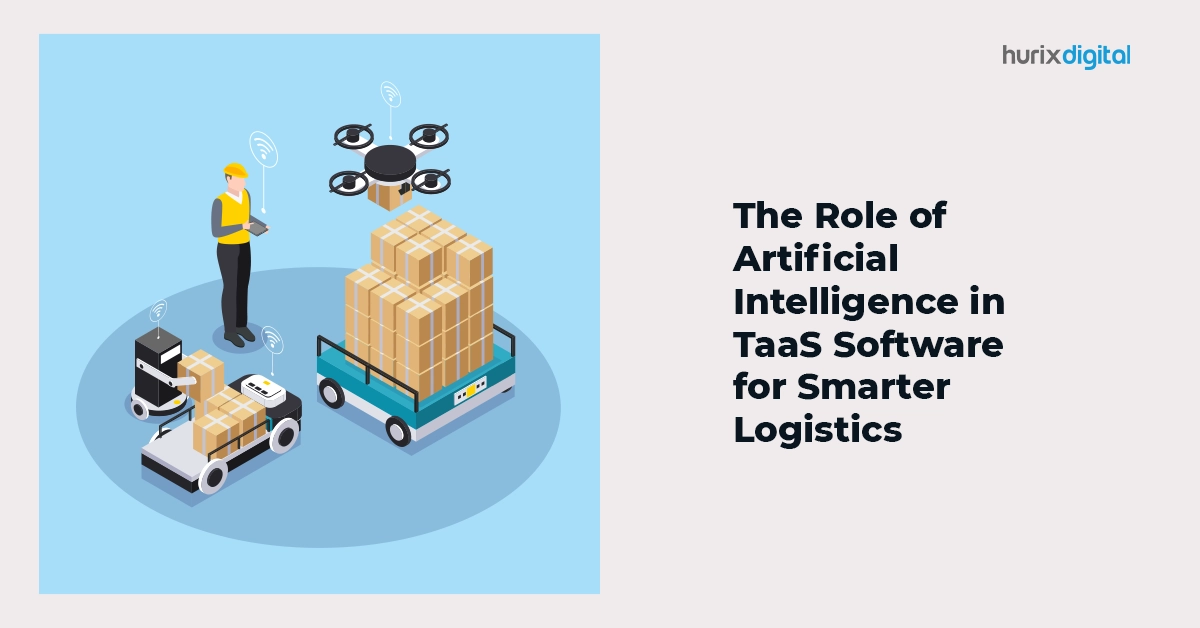
The Role of Artificial Intelligence in TaaS Software for Smarter Logistics
Summary
This article is all about the transformative power of AI in TaaS software. It covers how AI is streamlining logistics, enabling real time tracking, optimizing transport, and managing black boxes.
The logistics industry is the backbone of global trade, worth a staggering 24.9 trillion U.S. dollars. The industry is undergoing fast-paced technological advancements where AI-powered robots replace physical labor.
We live in a world of instant gratification, and TaaS software, backed by AI, is redefining how quickly we get what we want. Soon, the wait between ‘Add to Cart’ and doorstep delivery will be shorter than ever.
So, gone are the days of impatiently tracking packages because AI-powered logistics is streamlining supply chains, bringing us closer to the era of near-instant deliveries. This tech-titan is all set to revolutionize logistics as a whole.
Delve in to comprehensively understand the role of AI in TaaS software for smart and speedy logistics.
Table of Contents:
The Role of Artificial Intelligence in TaaS Software for Smarter Logistics
Successful modern logistics requires real-time data and intelligent decision-making. About 35% of businesses called out the time-consuming aspect of manual testing. Do not worry!
The TaaS software is here to help, offering a cloud-based platform for managing the intricacies of testing, deployment, and delivery. AI throws its technological prowess into the mix, transforming the software from a mere management tool into a predictive and proactive logistics mastermind.
1. Automates the TMS
TaaS software revolutionizes transport management by replacing manual processes with AI-powered automation. Instead of relying on outdated spreadsheets and manual coordination, it uses intelligent algorithms to guide deliveries with precision and efficiency. It makes transport operations seem like a well-tuned machine.
Efficient transport is the lifeblood of any successful logistics operation. Without it, meticulous warehouse organization and streamlined packaging strategies are hollow victories. In the 21st century, the once-dominant pen-and-paper reign has ended with automation. AI simplifies complex routes, predicts traffic patterns, and optimizes deliveries in real-time.
However, transport remains a physical challenge as unpredictable disruptions and last-minute changes pervade it. Recognizing this challenge, many logistics companies outsource logistics to 3PLs, creating a bottleneck for wider tech adoption. Such outsourcing sidelines mobile technology, which is crucial for AI integration.
2. Enables Real-Time Tracking
Outsourcing technologies, infused with AI’s brainpower, allow us to track shipments with eagle-eyed precision. Live tracking is a game-changer for impatient souls like us.
By gathering crucial data, AI predicts traffic and ETA of your order. This revolution is not just for giants. Even smaller businesses offer door-to-door transparency, letting you watch your package journey live from your couch.
AI ensures customer satisfaction and saves 10%-20% of fuel by optimizing routes. So, bid farewell to missed deadlines with AI-powered TaaS software for smooth logistics.
3. Enhances Black Boxes
Remember those old black boxes in planes? Truck versions are getting a serious makeover!
AI in automated tracking applications enables black boxes to predict equipment hiccups before they derail deliveries and ensure logistics flow smoothly. They keep track of engine temperature, tire pressure, and cargo weight to identify potential breakdowns before they occur.
Ships and planes also enjoy this facility, ensuring smooth and efficient logistics. It’s like giving the vehicle a super brain that constantly learns and adapts to optimize the journey, propelling us into the future of logistics.
4. Facilitates Scheduling and The Management of Warehouses
TaaS software coupled with AI’s foresight ensures sort-out warehousing where robots look after packages and deliveries on time and every time. Imagine a warehouse in overdrive where packages are rushed, and workers diligently try to keep up. It is like a constant battle against time and errors.
But, with the advent of Artificial Intelligence, one can forget overcrowded conveyor belts. Robots take charge of scanning barcodes and sorting packages, leaving no room for errors.
Studies show these systems reduce sorting errors by 80%, allowing humans to tackle more complex tasks. AI systems in logistics analyze past deliveries to predict future needs.
Scheduling becomes a piece of cake as warehousing layouts are optimized with AI-based applications. Delivery times are reduced by 25% owing to the seamlessness provided by AI in TaaS software.
Moreover, AI frees employees from tedious warehousing tasks, letting them focus on strategy and customer service. It functions on the notion of working smarter, not harder.
5. Utilizes Robots Optimally
TaaS software makes warehousing a breeze because it provides an extended team in the form of robots. Robots optimize the workflow and orchestrate flawless storage, packing, and delivery.
While AI in logistics often tackles the “paper shuffle” behind the scenes, it also takes care of the physical side of things with robots. Despite initial grumbles, warehouse robots are extremely useful, zipping packages around at lightning speed. Warehouse robots can boost productivity by a staggering 25-70% compared to human teams.
Moreover, these bots extend their services to cargo airports, effortlessly loading and unloading planes. They are like tireless workers keeping supply chains humming 24/7. Sure, there are valid concerns.
Contrary to popular belief about automation and potential job displacement, robots take over dangerous and repetitive tasks. It is about humans and machines working together, playing to their respective strengths to build a faster, smoother, and ultimately more efficient logistics future.
6. Performs Predictive Analysis
Integration of AI in TaaS software helps forecast future demand by anticipating needs and pre-positioning goods so that deliveries land as if teleported and not transported. Data aids futuristic logistics. Information about past orders, traffic patterns, and weather trends makes prediction possible.
Let us look at the three Ds this logistics mastermind can predict:
- Demand: AI forecasts demand patterns, allowing stores to have the right stuff exactly when they need it. Such forecasting helps you steer clear of “out of stock” issues.
- Disruptions: It anticipates interruptions like traffic jams and reroutes deliveries to keep things moving smoothly.
- Deliveries: AI estimates arrival times with accuracy. This allows customers to know exactly when to expect your package.
However, the future of AI is even brighter. Soon, it will prescribe solutions and even automate entire workflows to take logistics to a new level.
Also Read: Why Tech-as-a-Service (TaaS) is Gaining Popularity over the Traditional Approach?
To Wrap Up
The integration of AI-driven route planning and optimization in logistics through TaaS software not only yields immediate financial benefits such as reduced expenses and increased revenue but also fosters a ripple effect of operational enhancements.
For cutting-edge TaaS solutions, explore the transformative possibilities with Hurix Digital. We help improve resource allocation, reduce risks, and refine overall logistics operations, directly contributing to heightened customer satisfaction. Satisfied customers lead to word-of-mouth referrals and expand customer base. It is not just about speed but a step towards smart and sustainable logistics.
Get in touch with Hurix Digital to learn more!

SVP & Head – Hurix Technology Solutions
Global Delivery head with 25 years of working experience in NYC investment banks and fintech companies. Hands-on technology delivery management and program management, accountable for stakeholder relationships, Strategic roadmap, P&L, Revenue growth, Account Management, and employee satisfaction.



